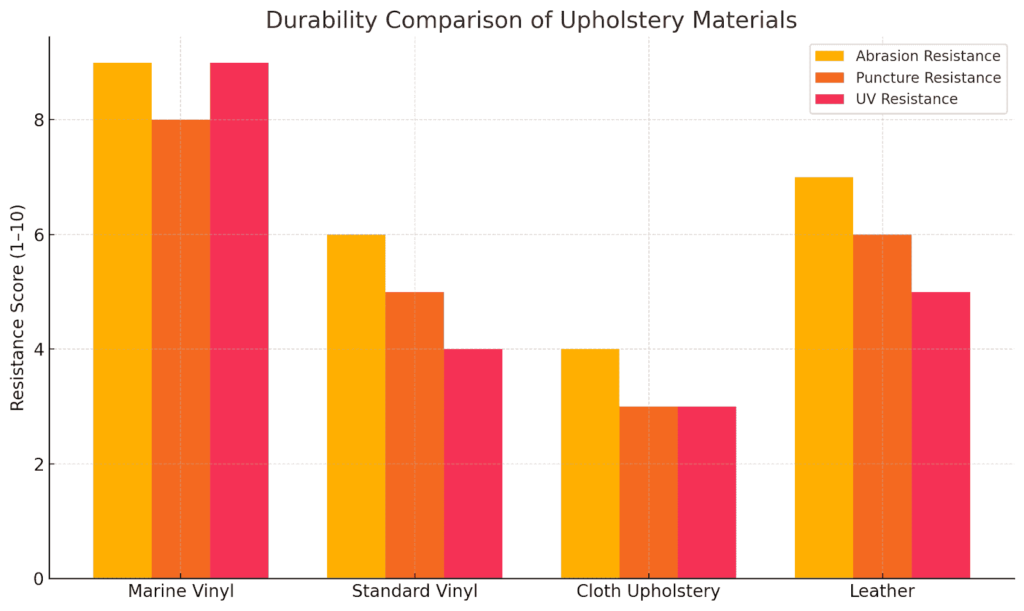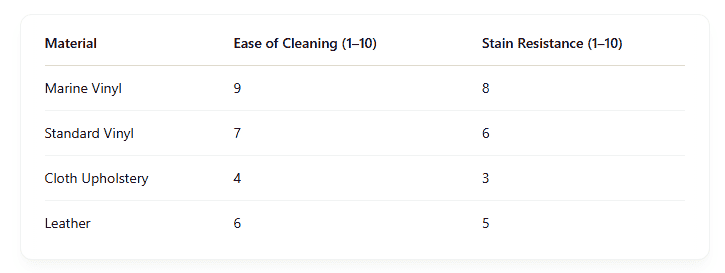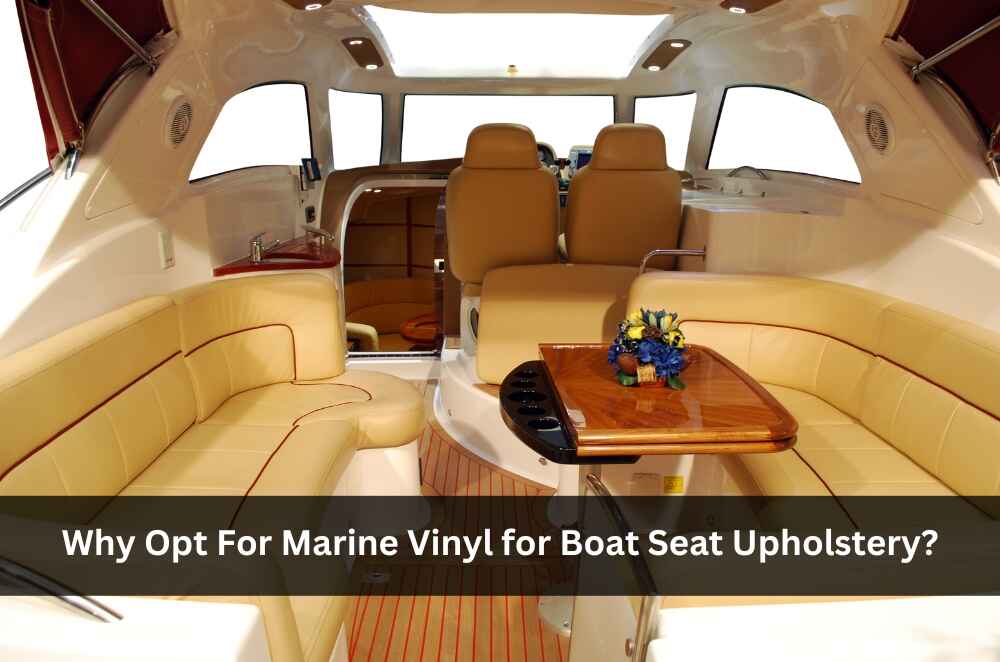Have you ever gotten a face full of splintered, dried-out vinyl when you plopped onto what once was a cozy boat seat? Or perhaps you’ve struggled with a crusty, mouldy cushion that smells far too strongly like low tide? If you’re an Aussie boatie, you’ve seen firsthand the reality we subject our favourite boats to from our unforgiving sun, salt spray, and surprise storms, particularly the areas we sit our backsides on. It’s not merely about looks when finding the right material for your boat seats; it’s about longevity, comfort, and not having your mates give you a hard time about your worn-out upholstery. For those looking to rejuvenate their watercraft, express boat seat fabrications offer an innovative solution—ensuring a durable and stylish finish that can withstand the Aussie elements.
What makes marine vinyl best for boat seats?
So, what’s the big deal about marine vinyl? Why do experienced boat owners and upholstery experts recommend it over other materials? It comes down to a unique blend of properties specially designed to meet the demands of life on the water. Unlike your typical automotive or household vinyl, marine-grade material is built to last.
- Designed for the elements: Seaside vinyl undergoes a specialised manufacturing process that imparts it with enhanced resistance to water, ultraviolet (UV) rays, and mildew. This allows it to withstand the relentless barrage of sun, saltwater, and humidity without cracking, fading, or becoming a science experiment.
- Durability that lasts: Consider the abuse your boat seats receive. Folks scrambling on and off with fishing equipment, salty dogs shaking themselves off, engine vibration day in and day out – it all adds up. Marine vinyl is built to take this kind of abuse, resisting punctures, abrasions, and tears far longer than regular vinyl or fabric.
- Ease of maintenance: Be honest; if you’ve been out on the water all day, the last thing you’d want is to go through a cumbersome cleaning ceremony. Marine vinyl’s non-porous surface means spills and dirt wipe off easily. Soapy water and some soft cloth do the trick to ensure your seats look shaped.
Is marine vinyl waterproof for boat upholstery?
This is a big one for Aussie boaties. Picture this: a sudden squall rolls in, soaking everything. With standard upholstery, you’re looking at waterlogged cushions that take ages to dry, potentially leading to mould and a generally unpleasant boating experience. Marine vinyl, however, is inherently waterproof. Whether out fishing, cruising, or simply exploring coastal views, marine vinyl’s durability and ease of maintenance make it the perfect choice for boat seats. No matter how much time you spend on the water, your upholstery will remain resilient against the harsh conditions.
- Non-porous barrier: Good marine vinyl’s closed-cell construction blocks water from getting through the material and wetting the foam underneath. This is important in keeping rot, mildew, and odious odour from developing, which no air freshener can ever eliminate.
- Sealed seams are critical: Although the vinyl is water-resistant, the seams where various pieces are sewn together can be a weakness. Expert express boat seat constructions frequently utilise heat sealing or waterproof thread to reduce water entry through these points, adding to the upholstery’s overall water resistance.
How durable is marine vinyl on boat seats?
Conditions can be challenging out on the water. Your boat seats have to withstand more than just cruising around. They constantly absorb heat from sliding bodies, the weight of gear, and the boat’s motion. Marine vinyl’s durability is one of the main reasons it’s so well-liked.
- High abrasion resistance: Good-quality marine vinyl has a close weave and a scuff-resistant topcoat that resists abrasion and scuffing. This allows it to withstand constant rubbing and movement without thinning out or forming unsightly bald spots.
- Tear and puncture resistance: No material is immune, but high-quality marine vinyl is highly resistant to punctures and tears. This is especially useful when used with sharp hooks on the rod or when a dropped tool meets it at the odd time.
- Flexibility and durability: Marine vinyl must be pliable enough to be stretched and moulded throughout the upholstery process yet durable enough to withstand stress without losing its integrity. The top marine vinyl balances these elements, providing pliability and resiliency.

Can marine vinyl resist sun damage on boats?
The Australian sun is a killer, and it can devastate boat interiors. Faded cracked vinyl is an all-too-familiar sight on older boats that have not been adequately protected. Marine vinyl is designed to counteract this.
- UV inhibitors: Good manufacturers add UV inhibitors to the vinyl during production. These substances work like sunscreen for your upholstery, stopping the damaging rays from degrading the chemical structure of the material, which causes fading, cracking, and loss of flexibility.
- Colourfastness: Good marine vinyl is engineered to maintain its colour even with extended exposure to sunlight. This ensures your blue seats don’t fade to a washed-out grey after a season or two.
Is marine vinyl easy to clean on boat seats?
At the end of a fishing day, swimming, or just sailing about in the harbour, your boat seats will have earned their share of grunge—fish scales, sunscreen, dropped drinks, and dirty footprints. The fact that marine vinyl is easy to clean is a huge bonus.
- Non-porous surface: Marine vinyl is non-porous, meaning that spills and dirt simply sit on the surface and don’t absorb in. This makes wiping off with a damp cloth or a gentle soapy solution easy.
- Stain resistance: Most good marine vinyl also has some stain resistance, so typical boating accidents such as spilled soft drinks or fish guts are less likely to leave a permanent stain.

Case study
In a recent case study with a commercial seating supplier company in the Asia Pacific region, I researched how they used marine vinyl for boat seat upholstery across various customisable seating solutions. The remarkable way marine vinyl significantly impacted both durability and passenger comfort, particularly in harsh marine environments. The company serves operators of commercial vehicles—such as boats—and ensures its products adhere to high safety standards such as ADR-68 and ECE regulations, making marine vinyl a practical boat safety feature. Its dedication to high-quality material was supported by the performance of the marine vinyl, which withstood wear, exposure to UV, and moisture without losing its looks. The material was also easy to clean and well-suited for high-traffic passenger vessels. Aside from safety and maintenance, the flexibility of the supplier to customise seats with options such as armrests, leg rests, and entertainment systems highlighted the functional versatility of marine vinyl. It’s an intelligent, long-term investment in comfort and regulation for commercial use.
Conclusion
Selecting the proper upholstery for your boat seats is a decision that affects not only the look of your boat but also its lifespan and your overall boating experience. While there might be cheaper alternatives, the superior durability, water resistance, UV protection, ease of cleaning, and mould resistance of marine vinyl make it the clear winner for Australian boaties. Spending money on good-quality marine vinyl instead, and even professional express boat seat fabrications if you can afford it, will pay dividends in the end by saving you time, money, and a great deal of frustration, keeping your boat a comfortable and enjoyable retreat on the water for many years to come.





Be First to Comment